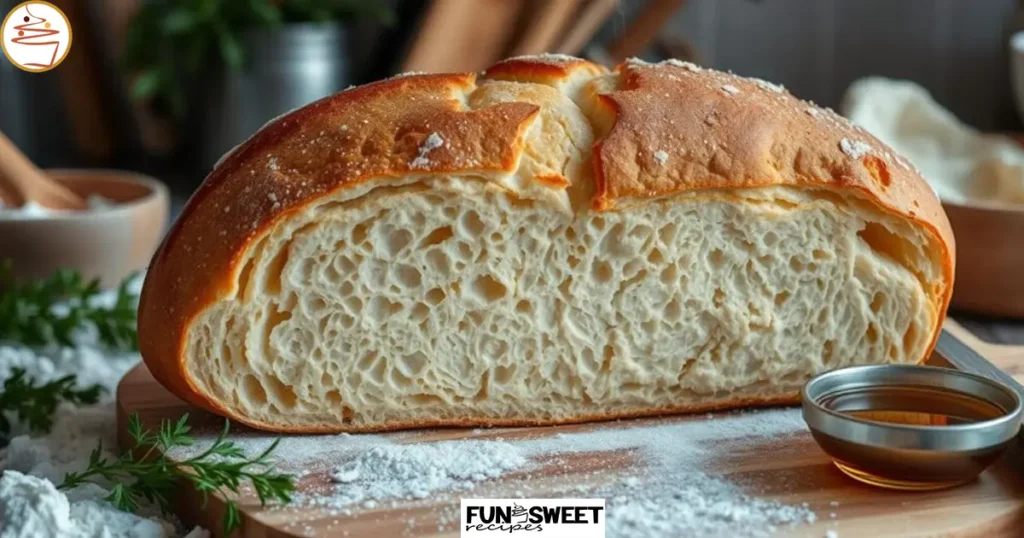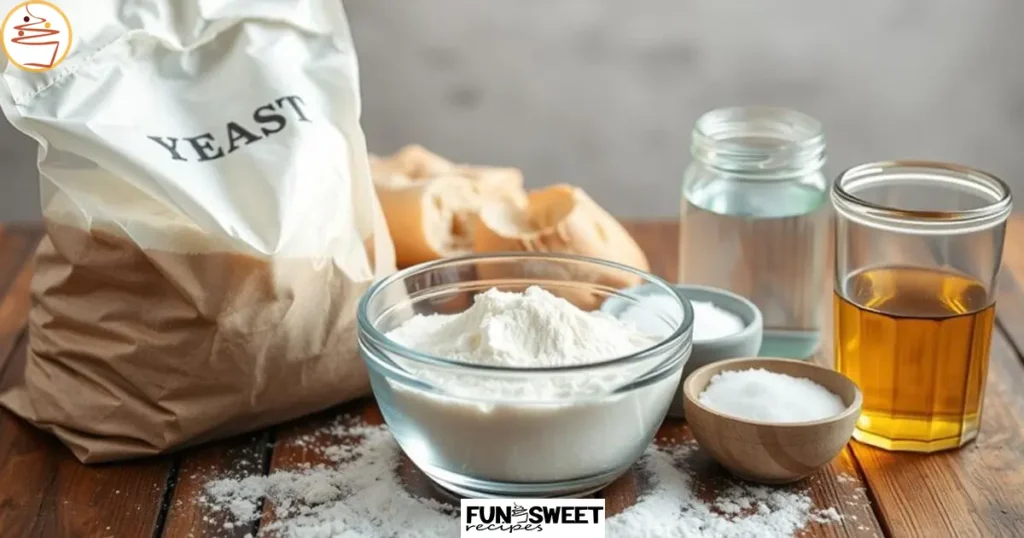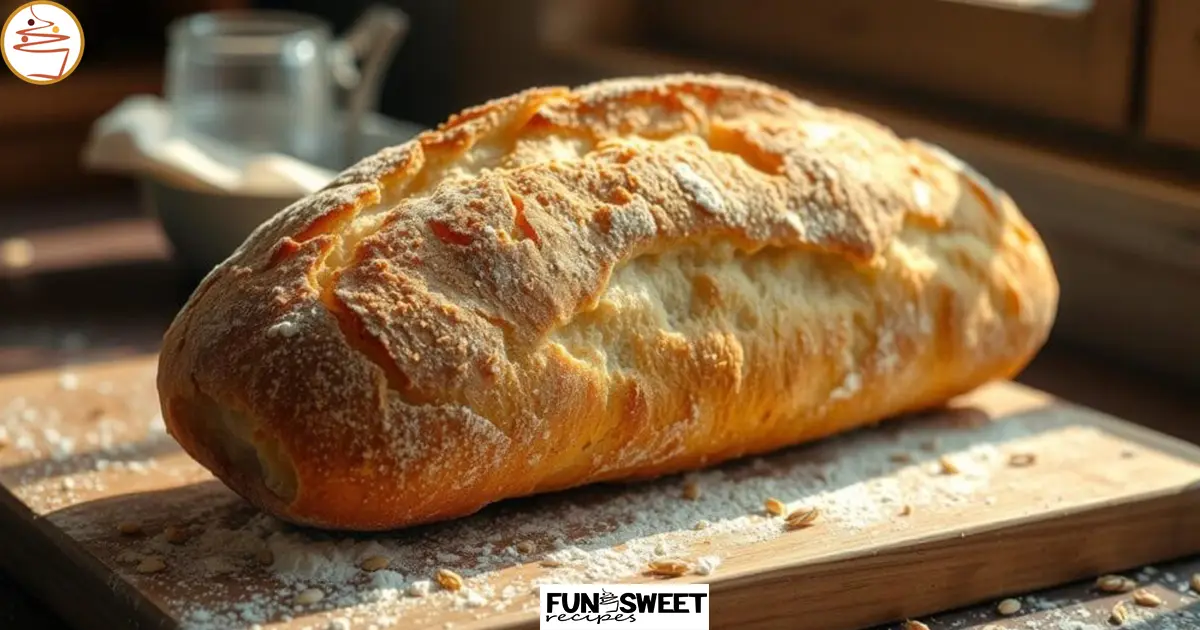The scent of new bread in the kitchen is bliss. I’ve worked hard to make the perfect French bread. This recipe makes two beautiful, crusty loaves that remind me of Paris.
This french bread recipe is easy and always turns out great. It only needs a few ingredients and simple steps. You’ll love making and eating this crusty bread at home.
Key Takeaways
- This homemade bread recipe yields two crusty loaves of authentic French bread.
- The recipe uses simple, common ingredients like all-purpose flour, yeast, salt, and water.
- The bread-making process involves mixing, kneading, shaping, and baking techniques to achieve the perfect crust and crumb texture.
- Baking this french bread recipe at home is a cost-effective and rewarding way to enjoy a classic bakery staple.
- The recipe produces a bread that is perfect for a variety of meals and occasions, from sandwiches to dinner accompaniments.

Why Making French Bread at Home is Worth It
Baking your own french bread has many benefits. It’s fresher and doesn’t have preservatives. Plus, you can make it taste and feel just how you like. Making easy french bread recipe at home is also very rewarding. It fills your kitchen with the amazing smell of fresh bread.
Benefits of Homemade vs Store-Bought
- Freshness: Homemade bread is always fresher than store-bought, as it lacks the preservatives needed for longer shelf life.
- Customization: You can experiment with different ingredients and techniques to create your preferred taste and texture.
- Sense of Accomplishment: Baking your own bread provides a deep sense of satisfaction and pride in your culinary skills.
Cost-Effective Baking Solution
Making french bread at home is also cheaper than buying it. You only need basic ingredients like flour, yeast, and water. This way, you save money and still get to enjoy delicious homemade bread.
“Baking your own bread is a simple pleasure that can transform your kitchen into a cozy, comforting haven.”
Some might think making french bread at home is hard. But it’s actually quite simple. With a bit of practice and the right methods, anyone can make amazing bread at home.
Essential Ingredients for Perfect French Bread
To make authentic French bread at home, you need a few key ingredients. You’ll need all-purpose flour, active dry yeast, salt, warm water, and a bit of sugar. These simple items work together to create the bread’s signature texture and flavor.
Begin with 4-5 cups of all-purpose flour. This flour gives the dough its structure and bulk. Use two packets or 4 1/2 teaspoons of active dry yeast to make the bread rise. Add 2 teaspoons of salt for flavor and 1 tablespoon of sugar to feed the yeast. Lastly, 1 3/4 cups of warm water will bring the dough together.
While not necessary, a bit of olive oil can add richness. Brushing the loaves with an egg white before baking will give them a golden crust. Using fresh, high-quality ingredients is crucial for the perfect French bread.
| Ingredient | Quantity |
|---|---|
| All-purpose flour | 4-5 cups |
| Active dry yeast | 2 packets or 4 1/2 teaspoons |
| Salt | 2 teaspoons |
| Warm water | 1 3/4 cups |
| Sugar | 1 tablespoon |
| Olive oil (optional) | A small amount |
| Egg white (optional) | For brushing the loaves |
With these french bread ingredients, you can make a fluffy bread recipe as good as Parisian boulangeries. The secret is using fresh, quality ingredients and following the right mixing, rising, and baking techniques.
Step-by-Step French Bread Recipe
Baking homemade French bread is rewarding. It makes fresh, crusty loaves with real flavor. Follow these steps to make your own French bread at home.
Mixing and Kneading Instructions
Start by activating the yeast. Mix 1/2 cup of warm water (110°F) with 2 tablespoons of dry yeast. Wait 5-10 minutes for it to get frothy.
In a big mixing bowl, mix 3 tablespoons of sugar, 1 tablespoon of kosher salt, and 6 cups of all-purpose flour. Make a well and add the yeast mixture, 2 cups of hot water, and 5 tablespoons of oil. Mix until it’s shaggy.
Then, work the mixture on a floured surface for almost 10 minutes. It should be smooth and elastic.
Proper Rising Techniques
- Put the kneaded dough in a greased bowl, turning it to coat all sides.
- Cover it with a moist towel or plastic wrap. Let it rise in a warm spot for 30-60 minutes, until it doubles in size.
Shaping and Scoring Methods
Punch down the batter to get freed of discussion bubbles. Split it in half and shape each into a rectangular loaf. Roll each into a cylinder and place on a parchment-lined baking sheet.
Use a sharp knife or lame to score the top with diagonal slashes, about 1/2 inch deep. Let the loaves rise for another 30 minutes before baking.

By following these steps, you’ll make perfect homemade French bread. Focus on yeast activation, kneading, rising, shaping, and scoring. This will give you the classic French bread texture and flavor.
Mastering the Perfect Crust and Texture
To get the perfect crusty french bread, you need a few tricks. The key to a great crust is steam in your oven. Place a pan of boiling water on the lower rack while baking. This helps your bread get an airy, golden-brown crust.
Also, brush your shaped loaves with egg white wash before and during baking. This keeps the bread moist and makes the crust crisper. It’s a simple step that makes the bread’s exterior crunchy and the inside soft.
The soft center of the bread comes from kneading and rising right. Letting the batter mature gradually improves flavor and surface. Make sure to let the bread cool a bit before slicing. This way, you’ll enjoy the perfect contrast between the crust and the soft inside.
“Achieving the perfect balance of crust and texture is the hallmark of exceptional French bread. With a few simple tricks, you can master this artisanal skill at home.”
- Use a water-filled pan in the oven to create steam, which delays crust formation and enhances oven spring.
- Brush loaves with an egg white wash before and during baking for a golden, crispy crust.
- Allow dough to undergo a long, slow fermentation to develop gluten structure and flavor.
- Let baked loaves cool slightly before slicing to maintain the contrast between crusty exterior and soft interior.
Tips for Creating Steam in Your Oven
Getting a crispy, golden crust on homemade French bread is all about steam. Home bakers can mimic professional ovens’ steam with a few tricks.
Water Pan Placement
Before baking, put a pan of boiling water on the lowest rack. This creates steam and keeps the dough moist. It helps make a beautiful crust.
Temperature Control Techniques
Some recipes say to preheat to 300°F, then turn it off. Let the bread rise in the steam before baking at 425°F. Keeping the oven at 350°F during baking is crucial for the perfect crust and texture.
Using these steam baking bread methods, you can get a pro-level crust at home. Try different techniques to see what works best for your oven and recipe.
Common French Bread Recipe Mistakes to Avoid
Baking homemade french bread is rewarding but can lead to mistakes. These mistakes can affect the taste and texture of your bread. To make a delicious, crusty loaf, avoid these common errors.
One common mistake is using water that’s too hot or too cold for yeast. The best temperature is between 105-115°F. Hot water can slaughter the yeast, whereas cold water won’t actuate it properly.
Another mistake is over- or under-kneading the dough. Kneading is important for developing gluten, but too much can make the bread dense. Not kneading enough means the dough won’t be strong or elastic.
Not giving the dough enough time to rise is also a problem. The first rise should last at least 1 hour. The second rise after shaping should be 30-45 minutes. Rushing this step can make the bread flat and dense.
Scoring the loaves too deeply can also cause them to collapse. Opening the oven door too often can disrupt the steam needed for a crisp crust.
Finally, measuring ingredients, especially flour, inaccurately can ruin the recipe. Too much flour makes the bread dry and dense. Too little flour can make it flat and gummy.
Avoiding these french bread troubleshooting mistakes will help you bake perfect homemade French bread every time.
Storage and Freshness Tips
To keep your homemade French bread fresh, you need to store it right. Let it cool down totally some time recently putting it absent. This usually takes 1-2 hours at room temperature. It’s important for the crust to stay crisp and the inside soft.
Proper Cooling Methods
After cooling, store your French bread in an airtight container or plastic bag. This keeps it fresh for 2-3 days. It prevents the bread from drying out or getting stale too fast.
Freezing Instructions
Freezing is great for longer storage. Cool the bread down first, then wrap it in plastic or a freezer bag. Frozen, it lasts 2-3 months. To warm it up, thaw it at room temperature and then bake for a few minutes.
By using these storage tips, you can enjoy your French bread for a long time. Remember, the right way to storing french bread and freezing bread keeps it tasting amazing.
Serving Suggestions and Pairings
Freshly baked French bread is a versatile delight. It sets delightfully with a wide run of dishes. Serve it warm, straight from the oven, with a dollop of butter or a drizzle of olive oil for dipping.
The crusty exterior and soft, airy interior make it an excellent accompaniment. It’s great with soups, stews, and hearty salads.
For a classic pairing, use the French bread as a base for bruschetta or garlic bread. Its neutral flavor complements both savory and sweet toppings. Try topping slices with a tomato and basil mixture, creamy hummus, or a tangy olive tapenade for a delightful appetizer.
The French bread’s sturdy structure is also perfect for sandwiches. Slice it lengthwise and fill with your favorite meats, cheeses, and condiments. It’s a satisfying lunch or snack. Additionally, the bread can be cubed and used as croutons to add texture and flavor to salads.
FAQ
What are the key ingredients for making French bread?
To make French bread, you need all-purpose flour (4-5 cups), active dry yeast (2 packets or 4 1/2 teaspoons), and salt (2 teaspoons). Warm water (1 3/4 cups) and a tablespoon of sugar to activate the yeast are also important. You can add olive oil for flavor and an egg white for brushing the loaves.
What are the steps involved in making French bread?
Making French bread involves several steps. First, mix dry ingredients and add warm water. Then, knead the dough until it’s elastic (about 10 minutes).
Let it rise until it doubles in size (30-60 minutes). Shape the loaves into rectangles and cylinders. Let them rise again (about 30 minutes).
Score the loaves with diagonal slits. Bake at 375°F-425°F for 20-25 minutes, using steam for a crispy crust.
How can you achieve the perfect French bread crust?
For a perfect crust, create steam in the oven. You can do this by placing a pan of boiling water on the lower rack. Brushing the loaves with an egg white wash before and during baking helps achieve a golden, crispy crust.
What common mistakes should be avoided when baking French bread?
Avoid using water that’s too hot or cold for yeast activation. Don’t over or under-knead the dough. Make sure to give enough rising time.
Scoring the loaves too deeply and opening the oven door too often are also mistakes. Accurate ingredient measurements, especially flour, are crucial to avoid dense bread.
How should French bread be stored to maintain freshness?
To keep French bread fresh, let it cool completely before storing. Store it in an airtight container or bag at room temperature for up to 2-3 days.
For longer storage, freeze the bread. Cool it completely, wrap it tightly in plastic wrap, and then place it in a freezer bag. Frozen French bread can last up to 2-3 months.

